Benedict (died 815) was the Abbot of Farfa, Italy from 802 until his death. He is the first abbot mentioned in the eleventh-century history of the abbey written by Gregory of Catino whose origins were not known. [1]

Gregory of Catino was a monk of the Abbey of Farfa and "one of the most accomplished monastic historians of his age." Gregory died shortly after 1130, possibly in 1133.
Benedict continued the policy of his predecessor of expanding Farfa's landed endowments. [2] Nevertheless, according to the forensic testimony of his successor, Ingoald, the monastery lost property during the reign of Pope Leo III (795–816), partly from the unlawful seizures of the Holy See. [3]
Ingoald was the Abbot of Farfa from 815, succeeding Benedict. At the beginning of his abbacy he vigorously protested the policies of Pope Leo III (795–816), which had resulted in the abbey's loss of property. Ingoald complained about not only the—illegitimate, as he saw it—seizure of Farfa's lands, but also the application of dubious laws of Roman origin in a zone that followed Lombard law. While Ingoald also fostered close contacts with the Carolingian rulers of Francia and Lombardy, he resisted secular encroachments on the abbey's privileges as staunchly as he resisted papal ones. The rate of property transactions at Farfa seems to have peaked under Ingoald, but the surviving documentary evidence is far from complete.
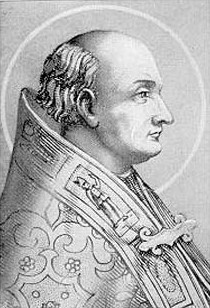
Pope Leo III was pope from 26 December 795 to his death in 816. Protected by Charlemagne from his enemies in Rome, he subsequently strengthened Charlemagne's position by crowning him Holy Roman Emperor and "Augustus of the Romans".
Two charters from 802 and 804 show that Benedict and his predecessor Mauroald financed the military service of two brothers from the Sabina, Probatus and Picco, sons of Ursus of the Pandoni family, who were serving the army of Charlemagne then targeting the Principality of Benevento. [4] In 804 they defaulted on their debt to the abbey of twenty gold mancuses, ten pounds of silver, and cloth worth sixty mancuses. They ceded all their wealth to the abbey save their lands in Fermo, a few movables and their slaves.
Mauroald was a Frankish monk from Worms and the Abbot of Farfa from 790. Farfa, at less than a century old, was still interested in accruing territories through grants and donations in order to support its building projects and the expansion of its site.

Sabina, also called the Sabine Hills, is a region in central Italy. It is named after Sabina, the territory of the ancient Sabines, which was once bordered by Latium to the south, Picenum to the east, ancient Umbria to the north and Etruria to the west. It was separated from Umbria by the River Nar, today's Nera, and from Etruria by the River Tiber. Today, Sabina is mainly northeast of Rome in the regions Lazio, Umbria and Abruzzo. Upper Sabina is in the province of Rieti. Sabina Romana is in the province of Rome. Part of Sabina is in the regions of Umbria and Abruzzo.
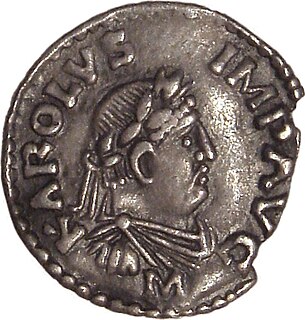
Charlemagne or Charles the Great, numbered Charles I, was King of the Franks from 768, King of the Lombards from 774, and Holy Roman Emperor from 800. He united much of western and central Europe during the Early Middle Ages. He was the first recognised emperor to rule from western Europe since the fall of the Western Roman Empire three centuries earlier. The expanded Frankish state that Charlemagne founded is called the Carolingian Empire. He was later canonized by Antipope Paschal III.
Teuto was the Abbot of Farfa from about 883 until about 888. His abbacy is the first of a string of very unclear ones that cover the years down to 919 at Farfa. He is known to have succeeded Anselm and been succeeded by Nordepert, but little else is certain. The period of his abbacy had already become obscure when Gregory of Catino was chronicling the abbey's history and editing its charters in the late eleventh century.
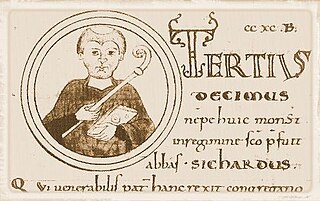
Sichard was a 9th century Italian Monk. He was the Abbot of Farfa from c.830 to 842. His abbacy corresponds with a drop in the number of property transactions involving Farfa, perhaps because "[its] wealth was by that time sufficient to cover major building at the abbey itself." Sichard added an oratory to the existing abbey.
Guicpert or Wigbert was the Abbot of Farfa for eleven months in 769–70 and probably also the Bishop of Rieti in 778. According to the twelfth-century chronicler of the abbey, Gregory of Catino, Wigbert was an Englishman and already a bishop when he convinced the dying Abbot Alan of Farfa to name him as his successor. From a twelfth-century perspective, Wigbert's accession was invalid because it was not in accordance with the Rule of Saint Benedict, although that rule was neither strictly nor uniformly enforced at Farfa in the eighth century. Nevertheless, the monks found Wigbert's rule a "tyranny" and sought the king, Desiderius, to remove him and confirm their freedom to elect a successor, which he did.
Wandelbert was the Abbot of Farfa sometime between 757 and 761, one of a series of abbots from Aquitaine. His abbacy coincided with a troubled period in the abbey's history and the stormy reign of Duke Gisulf of Spoleto, who seems to have brought some stability to the abbey by the time of his death.
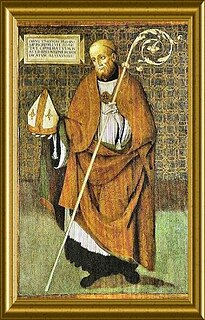
Thomas of Maurienne was the first abbot of the Abbey of Farfa, which he founded between 680 and c.700. Although the sources of his life are much later, and he is surrounded by legends, his historicity is beyond doubt.
Ragambald was the Abbot of Farfa from 781 until his death. According to the abbey's twelfth-century historian Gregory of Catino, Ragambald was born in a city in Gaul (Gallia), that is, Francia, but he does not explicitly call him a Frank. Succeeding Probatus, a local-born abbot, Ragambald was the first of a line of abbots from Francia, including Altpert (786–90) and Mauroald (790–802). The significance of the Frankish presence at Farfa and of Ragambald's abbacy is summed up:
.. . the ‘new’ abbeys of the time not only arose under Frankish influence but also infiltrated the religious life of Lombard Italy with ‘Frankish’ ideas and attitudes, providing a kind of ‘fifth column’ that prepared the way for Frankish military victory and a more ready acceptance of Frankish political domination.
Anselm (Zelmo) was the Abbot of Farfa between 881 and 883, succeeding John I. His short abbacy is reasonably well-sourced compared to the string of five abbots following him, beginning with Teuto, who were extremely obscure figures even to Gregory of Catino, the abbey's historian of the eleventh century.

Peter was the long-serving Abbot of Farfa from about 890 until his death. He replaced the interim abbot Vitalis. His abbacy marked the return of stability after a period which saw four abbots in the space of two years.
Altpert was the Abbot of Farfa from the death of Ragambald in 786 until his own death a few years later. He was described by Gregory of Catino, writing some three centuries later, as having been born in Paris "of the Gauls" (Galliarum), presumably meaning that he was a Romance-speaking subject of the Carolingians. He increased the patronage of the abbey compared to his predecessor, but Farfa was still less successful in seeking out grants and donations than it had been under the local abbot Probatus. Altpert received a donation of lands at Rabenno from Duke Hildeprand of Spoleto, two other donations and one oblation.

Fulcoald was the fourth Abbot of Farfa from 740. In 739 King Liutprand granted Farfa the right of freedom in abbatial elections, but we do not know if Fulcoald was the product of such a free election or not. Like his predecessor, Lucerius, Fulcoald hailed from Aquitaine, then in southern Francia. "With his abbacy, the quantity of our [historical] evidence dramatically increases [and d]evelopments in secular politics can now be seen to impinge on Farfa's land acquisitions." Fulcoald's abbacy can therefore be defined in terms of three objectives that are apparent in the surviving sources: (a) to extend its landholdings and secure its rights to its properties, (b) to promote a strict and disciplined monastic observance, and (c) to "steer as untroubled a course as possible through the choppy waters of Italian politics".
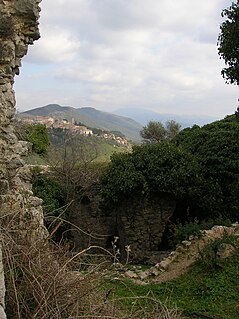
Alan was an Aquitanian scholar, hermit and homilist who served as the sixth Abbot of Farfa in central Italy from 761. Before taking over at Farfa, Alan composed the Homiliarium Alani, "one of the most successful homiliaries of the late eighth and early ninth centuries", traces of which may be found in the liturgical formulae scattered throughout Farfa's eighth-century charters.
Perto was the Abbot of Farfa from 854/7 to 872. Between 857 and 859 he received a privilege from the Emperor Louis II confirming a cella called Santa Maria del Mignone. Since this is the first time Santa Maria is mentioned in Farfa's possession it may have been acquired around this time by Perto. Louis's diploma confirmed privileges granted Farfa by his father, Lothair I, in 840. The imperial diploma forbade any financial imposition on Farfa by any pope or secular ruler. This diploma may have been aimed at courting good relations with the pope or it may be associated with Louis's intervention in the Duchy of Spoleto in 860. In 864 Louis confirmed Farfa's possessions and, at the insistence of Bishop Peter of Spoleto, protector of the abbey since 840, made a donation to it in the region of Massa Torana.
Spento was the Abbot of Farfa following the very brief abbacy of Nordepert in 888. As early as the next year (889), he was replaced by Vitalis, sometimes considered a surrogate abbot. During his brief tenure he reportedly acquired many lands for the abbey.
Nordepert was briefly the Abbot of Farfa in 888. He succeeded Teuto and was succeeded by Spento, but the exact dates of these abbacies were unknown as early as the eleventh century, when Gregory of Catino compiled the abbey's history. Nordepert appears to have been elected in the same year as he died.
John I was the Abbot of Farfa from 871/2. He made a few property acquisitions, but his abbacy comes at the start of an obscure period in Farfa's history. He received a confirmation from the Emperor Louis II of all of Farfa's lands on 27 May 872 and another from Charles the Bald in 875. Charles confirmed the abbey's freedom from taxation and secular jurisdiction and gave its abbots jurisdiction in suits involving subjects of the monastery's lands.
Hugh was the Abbot of Farfa from 998. He founded the abbatial school and wrote its history from the late ninth through the early eleventh century under the title Destructio monasterii Farfensis. A later student of his school, Gregory of Catino, wrote a fuller history of the monastery partly based on Hugh's earlier account.
Probatus was the Abbot of Farfa from 770 until 781, and the first abbot native to the Sabina. He steered the abbey through the fall of the Kingdom of the Lombards, trying to prevent the disastrous aggression of its last king, and kept it from falling under the jurisdiction of either the Papacy or the Papal States. With the benefit of his local connections he oversaw a great expansion of the abbey's properties through grants and purchases, and also rationalised its holdings to create a robust base for an early medieval monastic community.








